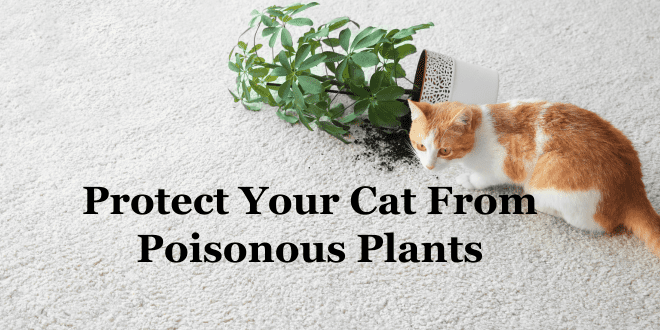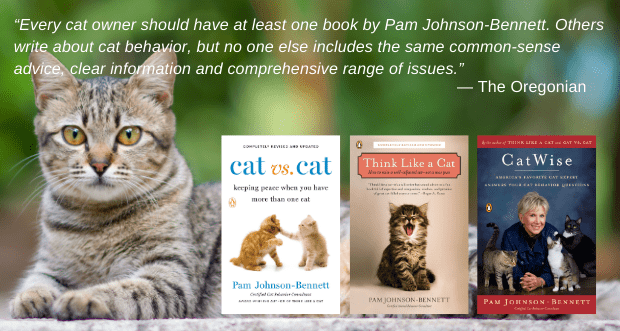
If you have a new kitten, chances are you’re watching him buzz around the house, checking out anything and everything! Your home is an exciting new world for a curious kitten but there are some dangers you need to watch out for. One area of concern has to do with houseplants. Even some adult cats can get into the habit of munching on forbidden greenery. Although it may seem innocent enough, most plants are poisonous to cats. The effects can range of minor irritation to being absolutely deadly. If you have hanging plants it creates even more enticement as the kitten or cat bats the plant in play and then bites down. Some cats who don’t have enough environmental enrichment can get into the habit of playing with and nibbling on houseplants just out of boredom.
What Plants are Poisonous?
For a list of poisonous plants, visit the ASPCA website. The list contains many pictures as well for easier identification. According to the ASPCA, here’s their list of the 17 most poisonous plants:
- Lilies
- Marijuana
- Sago Palm
- Tulip/Narcissus Bulb
- Azalea/Rhododendron
- Oleander
- Castor Bean
- Cyclamen
- Kalanchoe
- Yew
- Amaryllis
- Autumn Crocus
- Chrysanthemum
- English Ivy
- Peace Ivy
- Pothos
- Schefflera
There are some common plants, such as the dieffenbachia, that can cause intense burning and swelling of the tongue after just a few small bites. This can lead to difficulty in breathing. I see these plants included in many gift arrangements.
It’s important to make sure all potentially dangerous plants are kept completely out of reach. Some plants can cause immediate death no matter how quickly you get help so know the plants you have and remove the ones that are deadly. If you are going to keep plants, either indoors or outdoors, at the very least, know the names of them in case immediate identification is needed during a crisis and do your best to keep them out of your cat’s reach. When it comes to an outdoor cat, it’s pretty difficult to protect them should they decide to chew on outside greenery.
Signs of Plant Poisoning
Many of the signs will depend on the type of plant ingested. Some signs may include:
- Excessive salivation
- Vomiting
- Difficulty in breathing
- Diarrhea
- Fever
- Abdominal pain
- Mouth and throat ulcers
- Trembling
- Irregular heartbeat
- Red, itchy skin around the mouth
Treatment for Plant Poisoning
The treatment will depend on the type of plant ingested. If you can’t identify the plant, take it or a piece of it to the veterinary emergency clinic with you because they may be able to identify it. Your veterinarian isn’t necessarily a plant and garden expert but you stand a much better chance of helping your cat if you bring the plant with you so they can attempt identification.
If you think your cat has chewed on a poisonous plant, contact your veterinarian immediately. If it’s after hours and there isn’t an animal emergency clinic in your area, call the ASPCA Poison Control Hotline.
At the veterinary clinic, your veterinarian may induce vomiting in the cat, depending on the type of plant. Activated charcoal may also be given to absorb the poison. Additional tests may be administered to determine the extent of any organ damage. Your cat may also be put on fluid therapy.
If you’re unable to get to the veterinarian or emergency clinic, depending upon the type of poison, you may be instructed to induce vomiting. Don’t do it on your own unless you’re instructed to because in some cases, vomiting will cause burning and irritation again – as would be the case with the dieffenbachia plant. In some cases you may be instructed to use milk to coat and soothe the intestines. Again, don’t attempt anything until you’ve been instructed on the best course of action by a veterinarian or poison control expert.
Keeping Your Cat Safe
In our house, we’ve decided that it’s not worth the risk so we don’t keep live plants indoors. If you decide to keep plants or have chosen to only keep the ones that aren’t deadly, coat them with a bitter anti-chew spray. You can find these sprays, made especially for plants, at your local pet products store. Spray the plants, including the undersides of the leaves, being careful not to get any on your hands. I recommend wearing disposable gloves because the spray REALLY tastes awful. If you spray the plant indoors, protect your floors and carpets by putting paper or plastic down around the plant first. In some cases you may have to do a repeat spray in a couple of weeks. The spray doesn’t always deter cats, especially ones who are determined to chew, so if that’s the case with your cat, the safest thing to do is remove the plant.
Keep hanging plants cut short to reduce temptation. With plants near windows, keep in mind that cats tend to love sunning themselves at the window and also watching the birds outside. Provide your cat with several safe, plant-free window-lounging locations. Put a window perch at your cat’s favorite window or locate a cat tree nearby.
Redirect your cat’s interest to more interesting things. If the plant nibbling is happening out of boredom, step up the environmental enrichment. Here are some examples:
- Conduct interactive play therapy sessions at least once a day
- Incorporate the use of food-dispensing toys
- Rotate toys to keep them interesting
- Put out some boxes or open paper bags with toys inside
- Get a sturdy cat tree and place it by a window
- Keep a lid on the stress level in the home
- Provide safe chewing options (such as cat dental chew products)
Growing Safe Greenery for Your Cat’s Nibbling Pleasure
If you have a hardcore plant nibbler, try growing some safe kitty greens. You can buy these kits at your local pet product stores and online. You can also buy a patch of rye, wheat, or oat grass at your local organic food store or you can grow your own from seeds. Don’t use grass from the lawn because of the chemical fertilizers, weed killers, and pesticides it may contain.
Need More Information?
ASPCA list of Poisonous Plants
ASPCA Animal Poison Control (good information about many of the poisons you may have around your home and how to safeguard)
ASPCA Poison Control Hotline (888) 426-4435 (there’s a fee)
For more information cat behavior and training, refer to the books by best-selling author Pam Johnson-Bennett. Pam’s books are available at bookstores and online. We’ve included links to Amazon here on our website.
If you have a question about your cat’s behavior or health, contact your veterinarian. This article is not intended as a medical diagnosis nor is it a replacement for your cat’s regular veterinary care. This article is for general information purposes only.





